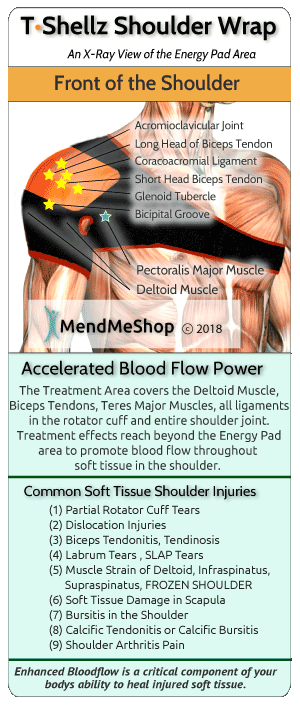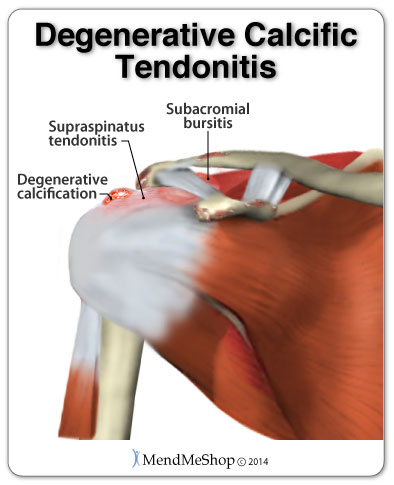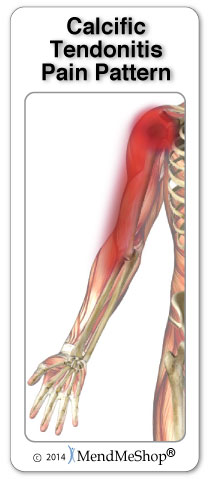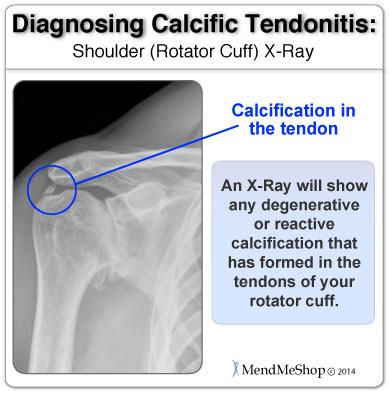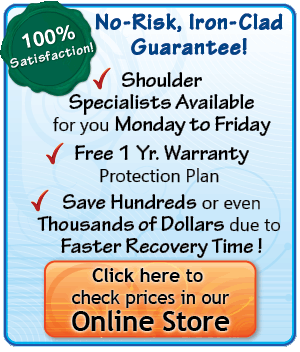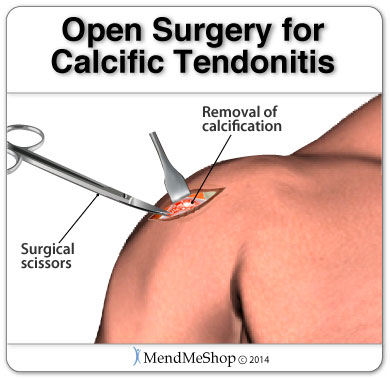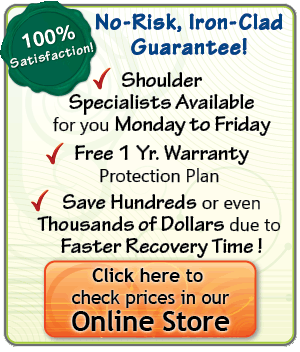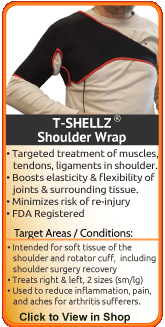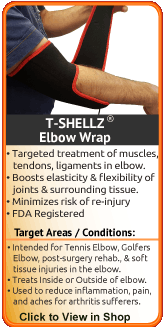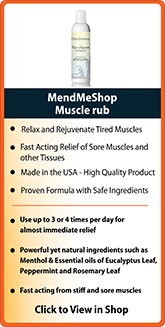Advanced Treatments for Calcific Tendinitis
How to Use Superior Home Treatments to
Heal & Relieve Pain from Calcific Tendonitis! You might be suffering from Calcific Tendonitis in your Rotator Cuff if:
- You have pain in your shoulder lasting a few weeks or months with no relief.
- You feel a sharp pain in your shoulder that shoots down your arm.
- You have a lot of pain that wakes you up at night or when you get up in the morning from laying on the affected shoulder.
- You're suffering from reduced motion in your shoulder and an inability to raise your arm and shoulder up without extreme pain.
- You sometimes feel a snapping, catching or weakness in your shoulder.
If any of those statements are true for you or you're suffering from on-going pain in your shoulder that intensifies over time and suddenly goes away then you might be suffering from "calcific tendonitis" in your rotator cuff. Calcific tendonitis is an injury that not a lot of people have heard about, and as a medical term the name for this condition is sometimes referred to as "rotator cuff disease".
Rotator cuff disease is really an injury or condition involving any injury or damage in your rotator cuff - to the tendons, muscles, or bursae. Calcific tendonitis means specifically the formation of bone spurs in the middle of your rotator cuff tendons. These spurs will form on their own naturally and will also go away on their own. While they're there though, they can cause pain, stiffness, and loss of movement in your shoulder and arm.
What is Calcification?
We use tendons everyday to stretch, pull and move, we have about 400 tendons in our body! Tendons are cord like pieces of soft tissue that connect our muscles to our bones. Calcific Tendinitis is a condition where calcium deposits (bone spurs) build in the middle of the tendon tissue. This condition is basically a natural chemical reaction with other tissues in the body the results in the formation of these spurs (an action called 'calcification'). Calcification can happen to anyone who has wear and tear, aging or degeneration in their rotator cuff - and sometimes there's no clear cause of this condition at all.
Calcific tendonitis is one of those injuries that can really bring down the quality of your life. In the early stages you might not feel a lot of pain, but the pain will increase as this condition goes on. The pain you feel will start to interrupt any of your normal daily tasks and make living life harder than it really needs to be. You might even start experiencing some sleepless night from the pain, or develop other conditions (like frozen shoulder) from resting and avoiding use of your injured shoulder.
Fortunately for you, professional athletes have had access to state of the art treatment therapies for years that allow them to heal more quickly and completely than you or I. This is why athletes that have a serious calcific tendonitis injuries can often get back in the game in a matter of weeks while you could suffer for months or even years (in chronic cases).
With some breakthrough products we have engineered, professional treatment is now available to anyone who needs it.
Calcific tendonitis can happen to anyone, not just professional athletes. Right now, there are thousands of doctors and physical therapists dealing with patients that require a solution to treat their calcific tendonitis fast and heal it (where possible). If you want to be proactive about properly addressing your calcific shoulder tendonitis, speak to your doctor about adding the Shoulder TShellz Wrap® to your home treatment plan.
Wondering How to Treat Calcific Tendonitis?
We Have Answers that can Help...
The goal of this web site is to give people hope that there are medically proven conservative treatments available for calcific shoulder tendonitis injuries. There's a lot of conflicting information posted online and we make it a priority to separate the fact from fiction.
We can offer many suggestions that could personally help you - right from the comfort of your own home. If you would like to discuss options with one of our trained AidMyRotatorCuff Advisers, we welcome you to call our office toll-free at 1-866-237-9608, or Internationally at +1-705-532-1671.
There is no cost or obligation to this service.
We all want to begin healing as quickly as possible and with the right information, it can happen sooner than you think (it has for thousands of others who took the time to contact us).
You can be assured we will do our best to answer any question or concern you have. Living with calcific tendonitis is never easy and we can help to provide answers about prevention, causes, treatment options, and ways to manage your injury for the short and long term.
All it takes is 1 call - 1-866-237-9608
What Causes Calcific Tendinitis?
There is no known cause of calcific tendinitis. All that medical professionals and doctors know now is that calcific tendonitis is NOT caused by: trauma to the area of injury, a sport / activity related injury and it's rarely part of a systemic disease. So far this condition is known as a natural process than can happen to some people and not others.
There are two types of calcific tendonitis of the shoulder affecting the rotator cuff:
Degenerative Calcification
Aging and normal (everyday) activities can cause wear and tear on the tendons in your shoulder. This wear and tear slowly weakens your tendons over time and can cause small tearing or fraying (kind of like a rope frays as it's used). Aging also decreases the blood flow to the tendons of the rotator cuff. Normally, degenerative calcification affects people over the age of 40.
Overworking and overusing the shoulder can cause tendonitis. Tendonitis is a condition that has resulted in small microscopic tears in the tendon tissue. As a part of the normal healing process your body will react to this tendonitis with swelling and inflammation in your shoulder. Unfortunately aging of tendon tissue reduces blood flow to the rotator cuff tendons, starving the tissue from oxygen and nutrients needed for natural healing as well. This is bad news because you need blood to heal the tendon completely. In this case your tendon will make calcium deposits in your tendon tissue instead of using natural blood flow to actually make strong, healthy tissue fibers.
Reactive calcification
There is still some mystery surrounding the cause of reactive calcification. The stages of this type of calcific tendonitis can start when you're younger and progress until you're in your 40's (or even later in life). So far there is no clear cause of reactive calcification.
This condition normally affects younger women more so than men. There are 4 stages of reactive calcification:
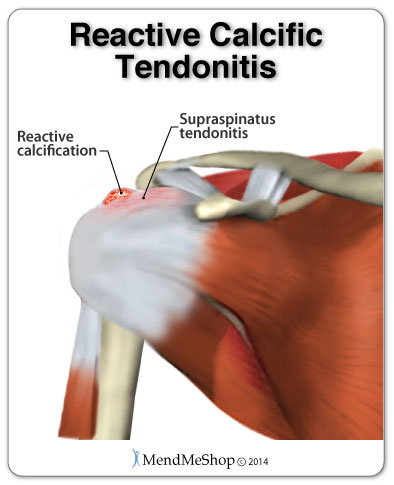 - Stage 1: Pre-calcific - A natural chemical reaction in the cells causes the calcium to form inside the tendon itself. The calcium deposit will get bigger and look like a piece of chalk (hard, dry).
- Stage 2: Resting - The chalk-like calcium deposit enters a resting period and may or may not be painful. At this point the deposit may be large enough to reduce the range of motion in your shoulder.
- Stage 3: Calcific - This is the most painful part of all the stages. The body is trying to break down the calcium and reabsorb it into the tendon tissue. This stage sparks inflammation and the calcium crystals turn into a 'liquid' much like the consistency of toothpaste, and may leak into the surrounding tissue (ultimately causing other conditions like shoulder bursitis / subacromial bursitis).
- Stage 4: Post-Calcific - The healing cycle continues in the tendon and remodelling of the cells helps to create new tendon tissue. The pain decreases as the calcium deposit is re-absorbed into the tissue and disappears completely.
What Are The Symptoms Of Calcific Tendinitis?
If you're suffering from calcific tendinitis you may experience:
- Pain and stiffness that lasts for a few weeks to 2 months and suddenly disappear. If your calcific tendinitis injury comes back a number of times, you could now have a chronic condition and notice pain that lingers for a few months to years.
- Pain that radiates from the point of your shoulder half way down your arm.
- Pain that intensifies when you raise your arm above your shoulder level.
- Reduced range of motion in your arm and shoulder.
- Pain that wakes you up at night if you're sleeping on your side or your affected shoulder.
- Snapping, catching or/and or weakness of your shoulder.
How do I Diagnose Calcific Tendinitis?
Visiting your doctor when you have pain is always recommended, as there are many possible issues that can happen in your shoulder.
To begin with, your doctor will gather a medical history about you and your current condition and symptoms. They'll ask about the intensity of your pain, how long your symptoms usually last and the limitations you're experiencing. Details about when it started and whether or not you have ever had treatments for this or a similar condition in the past are very helpful in assessing your shoulder injury.
Your doctor will also look and feel the bones and soft tissue in your shoulder to see what kind of pain you're having. They'll be looking for any differences between you injured shoulder and your healthy shoulder. This will help them to feel any abnormalities - like mild or severe inflammation, bone deformities, atrophied muscles (muscles that have wasted away due to injury), redness and/or warmth on the skin.
One set of symptoms can result in multiple diagnoses. An X-ray, MRI or visual ultrasound is needed in order to clearly diagnose calcific tendinitis and know the extent of the soft tissue damage. Any calcium deposits in your tendons should show up clearly in an x-ray.
We have tools that will help you to treat the symptoms of calcific tendonitis. When it comes to your injured rotator cuff, it's best to start effective long term healing right away. Our Advisers are highly trained individuals and will help find the long term healing goal that's right for YOU. Why wait?
Call today and get on the road to recovery faster than ever before!
How Do I Cure Calcific Tendonitis -
What Can I Do?
We Have Advanced Treatment Tools Designed to Ease Pain, Reduce Inflammation, Reduce Re-Injury Risk and Speed Up Your Recovery from Calcific Tendonitis
The good news is that most cases of calcific tendonitis will heal with simple home conservative treatments and surgery is often not needed!
It's generally understood by doctors and surgeons, that surgery will introduce more scar tissue into the shoulder. This added scar tissue will be problematic, requiring visits to the physio clinic and conservative treatment options post-surgery. When it comes to calcific tendonitis there's only 1 surgical option for treatment - removal of the calcium deposit through arthroscopic, needling or open surgery. This is why surgery is only performed as a last resort for chronic calcific tendonitis injuries that won't heal with conservative treatment methods, or calcium deposits that won't re-absorb back into the tendon.
Some conservative treatment methods recommended include:
- Rest - This is important for initial healing because without proper rest you're at risk for increased pain or inflammation in your shoulder. Without proper rest you could end up making your calcific tendonitis even worse and turn an acute injury into a chronic one.
- Avoid Activities that Increase Your Pain - While resting your shoulder it's also important to avoid all activities that increase your pain. This would include raising your arm above shoulder level, or using your injured shoulder for everyday activities. Continuing on with regular activities will not only make your injury worse, but also result in major set-backs in your recovery.
- Apply Cold Compression when experiencing significant inflammation - the use of a Cold Compress or Ice Pack will help you to manage pain while getting rid of your swelling and inflammation. Immediate pain relief and reduced inflammation can also relieve some of the pressure that's being placed on your rotator cuff tendons and stop your injury from getting worse.
- Use a TShellz® Circulatory Boost Wrap - After any inflammation and/or swelling has been reduced, you can use your own blood flow to maximize healing of damaged tissue and maintain healthy blood flow to your rotator cuff. This will also boost overall long-term healing of this injury.
- Stretch Your Shoulder - Stretches and exercises prescribed by a physical therapist or doctor could help to increase your range of motion and improve any muscle strength lost from resting your shoulder.
- Attend Physical Therapy Appointments - Your physical therapist may ask you about using clinical ultrasound (which uses a sound waves) to help reduce the size of the calcium deposit. Ultrasound needs to be repeated often in a six to eight week period up to 24 times visits to see full results. Another treatment your physical therapist might want you to try is extracorporeal shock wave therapy (ECSW). With this technology sound waves are targeted into the tissue to help reduce the size of the calcium deposit. This therapy would need to be repeated every other week for 3 to 18 visits depending on the size of the deposit.
Effective Conservative Treatment Options
are Available
If your doctor has decided that your calcific tendonitis can be treated with conservative treatment, you can join our many customers who have had great success in treating themselves with the powerful, conservative home treatment T•Shellz products we offer through AidMyRotatorCuff.
If you need to have surgery, talk to your doctor about using these same products for post-surgery recovery. You'll find them effective for reducing post-surgery inflammation, enhancing range of motion and minimizing the growth of scar tissue in your shoulder.
What if You Need Surgery?
Whether you need to have surgery and the type of surgery you'll have depends on the severity of your calcific tendonitis. The longer you've waited to have surgery or try conservative treatment methods will also be a factor to decide if you need surgery.
Has it been weeks or months since the injury?
An acute (recent) case of calcific tendonitis is usually treated with conservative treatment methods, like rest, minimizing activity, cold compression and Circulation Boost as we mentioned before.
Doctors and surgeons will always avoid surgery if possible because recovery from the surgery can be a lengthy process - especially because the calcium deposit is being removed from your tendon. Doctors always prefer minimally invasive treatments which is why they suggest conservative treatment first. Your doctor and surgeon know that a surgery will involve altering the structure of your foot, and so they will recommend treatment to avoid surgery at all costs.
Scar tissue will be problematic for long-term recovery after surgery.
As with any surgery there are risks to every procedure depending on a lot of factors, including your age, the severity of your injury and your level of health going into the procedure. It's always best to discuss all possible risks and complications with your doctor, orthopaedic specialist and/or surgeon before the procedure. It's important to be aware of the risks you may face with any procedure intended to fix or relieve pain from your calcific tendonitis.
If you've exhausted all forms of conservative treatments and you still have calcific tendinitis you and your doctor may decide to move forward with surgery. There are few types of procedures or surgeries they may preform:
Minimally Invasive Procedures
Your doctor may suggest trying a procedure called lavage. During this procedure your doctor will insert two large needles into your shoulder and inject sterile saline (salt water solution). The salt water is used to rinse the tendon, and sometimes this rinsing method will help to loosen up your calcium deposit. If the lavage treatment is successful your body will have an easier time re-absorbing the calcium deposit. It could speed up healing and may reduce pressure in the tendon, reducing your pain.
Your doctor may also suggest needling. For this procedure the doctor will attempt to break up the calcium deposit by repeatedly inserting a needle in the area. They also may or may not inject a saline (salt water) solution at the same time.
Arthroscopic Surgery
For this surgery your surgeon will make small incisions in your shoulder then insert tools and a camera (arthroscope) to remove the calcium deposit and see inside your shoulder joint. Sometimes the surgeon will use the needling technique or make a small incision in the tendon and tease out the calcium with a hook. This type of surgery is much less invasive and you can return to daily life much sooner.
Open Surgery
If an arthroscopic procedure can't be done, your surgeon might use an open incision in the skin to expose the area in the shoulder where the calcium deposit is in the tendon. The calcium deposit would then be cut out and the edges of the tendon where the calcium attached itself are also cut away (a process called debridement). After this the remainder of the tendon is stitched back together. This is a much more involved surgery than an arthroscopic procedure - so you may need to wear a sling for up to 3 days and start physical therapy range of motion exercises at that point.
Conservative Treatment Methods Will Very Likely Be Recommended by Your Doctor for Recovery after Your Surgery
Remember that surgery isn't the end of your journey, it's just the beginning of a new chapter. Your rehabilitation efforts will have an important impact on how soon you can return to living and enjoying your normal daily life.
Your rate of recovery after the surgery will depend on how dedicated you are to the conservative treatment method recommended by your doctor, the type of procedure that you had and your efforts in physical therapy.
No two rehabilitation plans are alike - Generally speaking the less invasive your
surgery is, the quicker your road to recovery will be.
Use These Conservative Treatment Methods to
Avoid Surgery & Speed Healing After Surgery!
If you suspect you have calcific tendonitis...
- Usually conservative treatment methods are all that's needed to treat calcific tendonitis, surgery is only ever used if long-term conservative treatment methods don't work or if you're suffering from a chronic case of calcific tendonitis. Conservative treatment options for calcific tendonitis typically includes rest, icing of the injury, avoiding activities that cause or worsen the pain that you're feeling, and anti-inflammatory over-the-counter medication (reference: 1, 2).
- Second, if your doctor has decided that your injury can be treated with conservative treatment options, then you'll find that many of our customers have had great success treating themselves with our powerful conservative treatment products - the Cold Compress or Ice Pack and TShellz Wrap®.
- Or, if surgical intervention is required, talk with your doctor about using these same products for post-surgery recovery as you'll find them to be effective for reducing post-surgery inflammation, enhancing range of motion and reducing scar tissue growth.
When the calcium deposits are being reabsorbed, the pain can be especially bad. There are a number of ways to relieve your pain with conservative treatments.
Step 1 - Reduce Pain & Swelling with Cold Compression
The 1st step for conservative treatment of your calcific tendonitis is to reduce the swelling to "open up" the area for more blood flow. Anyone in the health-care business knows that your blood supplies the oxygen and much needed nutrients required to heal sesamoiditis injuries. This is why for years doctors, trainers and other medical professional have recommended RICE (Rest, Ice, Compression, Elevation) to treat the pain and swelling of fresh injuries, chronic pain, and after any re-injury.
This is important because once blood vessels are blocked or damaged, they can no longer carry oxygenated blood through the tissue and tissue begin to break-down. Without cold compression, cellular break-down and tissue damage continues as the cells don't get the oxygen they need to survive. By limiting the amount of damage done to your tendon, you also limit the amount of healing that needs to occur. This is a very important step to heal tendon injuries faster and with less pain! This is why you need to treat your calcific tendonitis right after it's hurt, when you notice pain / swelling / inflammation, or directly after a re-injury.
Use a Cold Compress or Ice Pack:
- 24 to 72 hours after your initial injury or when you first notice pain and swelling in your shoulder to stop tissue damage, relieve pain, and decrease swelling.
- After exercise, workouts or activity of any kind to prevent re-injury of your shoulder.
- Before and after surgery during rehabilitation to control pre and post-surgery pain and swelling.
- Anytime you feel your calcific tendonitis has made your shoulder tender, painful or you're having a flare-up of an old calcific tendonitis injury.
- Anytime you have swelling, sharp throbbing pain or inflammation in your shoulder.
- Any other situation where you need to draw the pain and inflammation out of your shoulder.
Step 2 - Improve Circulation & Speed Up Healing with a TShellz Wrap®
After the inflammation around your shoulder has been reduced, you need to provide extra blood flow to strengthen your tendon tissue and continue to help your body flush out the calcium deposit naturally.
Using Circulation Boost (TShellz Wrap®), will help with your recovery and heal your tendons more completely. A TShellz Wrap® treatment increases the amount of blood that flows naturally to your soft tissue to nourish your tendons, improving elasticity and speeding the healing process. This increased Blood Flow to your tendons and muscles are greatly needed while the body tries to re-absorb your calcium deposit.
- When treating calcific tendonitis or any soft tissue injury, an effective treatment will increase blood flow to the injury while the joint is immobile.
- This increase in blood flow will help maximize the body's own capability to heal itself.
Use a TShellz® Circulatory Boost Wrap:
- After swelling and inflammation have been reduced with cold compression.
- Before exercise or workouts to warm up your shoulder to prevent re-injury.
- Before and after surgery during rehabilitation to warm up your tissues before physical therapy exercising or stretching.
- Anytime you feel the tissue in your shoulder has stiffened up, is tight and your mobility is reduced causing you more pain.
- Anytime you have sore or aching tissue in your rotator cuff.
- Any other situation where you need to increase blood flow to your shoulder to relax your soft tissue, relieve pain, prevent re-injury, enhance flexibility of your tissue, and improve blood flow circulation.
Our Calcific Tendonitis Therapy Formula
is Proven to Work!
It may seem hard to believe, but our TShellz Wraps® will assist you in recovering from your injury faster and reduce the chance of your calcium deposits from returning or suffering from other degenerative conditions in your tendons by maximizing blood flow where it's needed most and reducing swelling / inflammation induced pain.
Here at AidMyRotatorCuff we pride ourselves in helping you with your healing and recovery process. Everyone at AidMyRotatorCuff has tested and used the products, finding solutions to conditions that do not fit into the norm. This dedication to our customers and our products goes hand-in-hand with our guarantees to you as a customer:
- Guarantee #1 - Use your products diligently for up to 60 days and you will experience a significant reduction in pain. If not, I encourage you to send back the items for a 100% refund.
- Guarantee #2 - You will not be left in the dark after purchasing any product form us. AidMyRotatorCuff Advisors and Product Specialists are available Mon - Fri by toll free phone 1-866-237-9608 or email to answer your questions or concerns.
- Guarantee #3 - Your order is guaranteed to be shipped within 24 hours on every business day.
- Guarantee #4 - All purchases receive a one year, full replacement warranty with guaranteed, prompt service.
- Guarantee #5 - You could save hundreds of dollars and possibly more, by utilizing our products, and getting back to work sooner.
Prevention and Promotion of Lifelong Health
If you want to avoid re-injury, manage pain and increase circulation for lifelong health benefits, start utilizing a home based therapy with the use of a Cold Compress or Ice Pack and a Shoulder TShellz Wrap®. The TShellz Wrap® will provide exceptional results. Why spend time in pain, off from work, and missing out on your active lifestyle when you can be proactive about your injury and the health of your body?
Call one of our AidMyRotatorCuff Advisers at no cost or obligation to address any lingering questions you have about using our products for your calcific tendonitis - toll free 1-866-237-9608
Click HERE to Go To Our Online Store We take all major credit cards and Paypal.
If you have questions, call our office at 1-866-237-9608 (toll free continental US).
We are currently offering FREE SHIPPING and a 60 day trial period on all our Wraps.

Product specialists are available 9:00 am to 5:00 pm Eastern Standard Time Monday to Friday. If any question or concern arises, call us or simply send us an email at any time (we check our emails constantly all throughout the day and night.. even on holidays!). We will respond as soon as possible. North America Toll Free 1-866-237-9608
Outside North America +1-705-532-1671
Learn More About The Rotator CuffLearn more about Shoulder Surgery and Post-Surgery Recovery Learn more about The TShellz Wrap Learn more about which is better for your rotator injury - ice or heat
FREE SHIPPING ON ALL PRODUCTS CURRENTLY ENABLED
60 DAY TRIAL PERIOD
During your recovery, you will probably have to modify and/or eliminate any activities that cause pain or discomfort at the location of your soft tissue injury until the pain and inflammation settle. The more diligent you are with your treatment and rehabilitation, the faster you will see successful results!
| 












